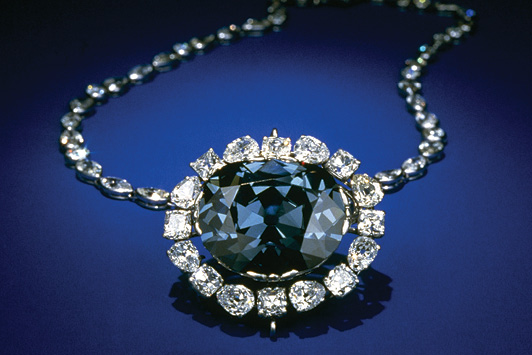 The 45.52-carat Hope Diamond.
The 45.52-carat Hope Diamond.There’s a legend that shows up in a few different places,
about a renowned explorer — the real Alexander the Great in some books, the
fictional Sinbad the Sailor in others — who is faced with the challenge of
collecting diamonds. The stones sit at the bottom of a shadowy and forbidding
valley, guarded by serpents that, in one colorful version of the story, have
the magical ability to look men in the eye and turn them to stone. The hero has
a plan to lower a mirror into the pit, and sure enough, when the snakes glance
into it, their charm backfires: They petrify themselves. Still, even with the
enemy vanquished, the men are hesitant to climb into the valley. Their leader,
whom they’ve followed deep into the Hindu Kush, has another thought — he’ll
consult the wise men of the region about how best to claim the treasure.
The elders offer strange advice. The hero
returns and instructs the group to throw raw meat into the valley and wait at
the top of the mountain. They do it, and sure enough, the odor attracts a pack
of vultures that swoop down and pick up the meat. As the birds make their
ascent, the hero tells his troops to follow them. The vultures fly overhead and
escape, but as they rise further and further into the air, small pebbles rain
down from the sky. The men scramble to pick them up. To their delight, it’s the
diamonds; they stuck to the raw flesh just long enough to be lifted out of the
darkness.
A centuries-old appeal This account appears everywhere, from the writings of
13th-century Persian scientist and storyteller Zakariya al-Qazwini, to the
dispatches of Marco Polo, to the classic
One Thousand and One Nights. But in
the end, it doesn’t really matter whom it’s about or where it came from,
because it’s an entertaining adventure that also reminds us just how long
diamonds have been prized. The message is clear: It’s worth making a stop at a
harrowing snake pit just to gather the crystalline gems.
Diamonds have meant money, prestige and
power since at least the 1200s, when Marco Polo traveled to India and then
published books in Europe about what he saw. They’ve meant plenty of other
things, too. Today, as the story of diamond marketing in the 20th century
becomes increasingly well known, it’s worth looking back at how the stones were
perceived before they were being advertised in the pages of
Town & Country,
The New Yorker and
Vogue. Long before anyone understood the science behind
diamonds or even where to find them, they were a
subject of fascination.
Cross-cultural powerFrom India to Syria to Rome to Greece, ancient cultures
have ascribed miraculous, otherworldly powers to diamonds, using them in
religious artifacts and, of course, jewelry. Indian maharajahs wore rough
diamonds — the bigger the better — because they thought the stones gave them
strength. In the Middle Ages in Europe, diamonds were thought to have active
medical properties, able to do all sorts of wonderful things: cure diseases,
promote fertility and even end arguments between couples (well, maybe that last
one is true). Even though we know better now, the heart of the deep,
cross-cultural diamond tradition remains as clear — and as relevant — as ever.
A real diamond will always be a little bit
mysterious, a little bit unknowable. Even with all of the resources we have at
our fingertips, we’ll never fully understand the diamond’s astonishing journey.
With many now debating the question of its value, this is a good time to recall
the mystique and inherent beauty that have drawn people to this stone
throughout history.
Image: Alamy Stock PhotoArticle from the Rapaport Magazine - Special Supplement Ancient Beauty, Bold Future. To subscribe click here.